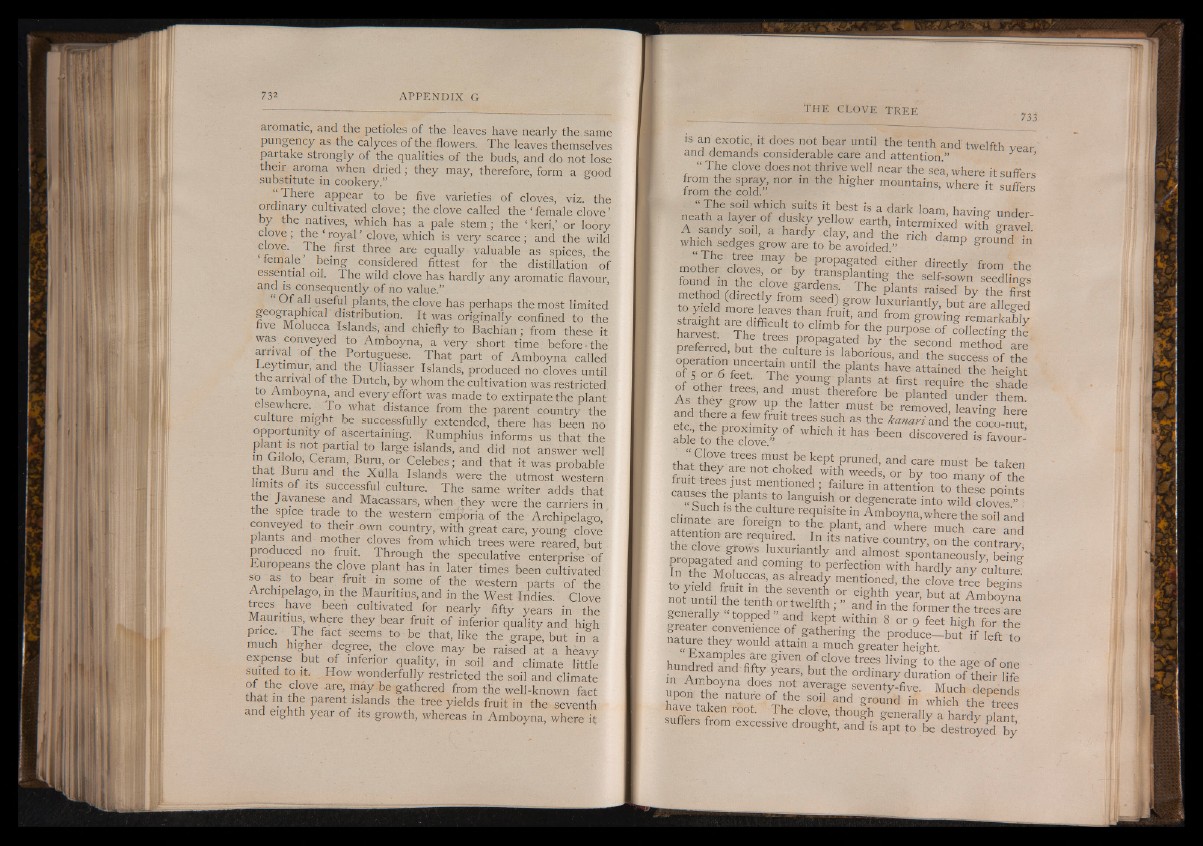
aromatic, and the petioles of the leaves have nearly the, same
pungency as the calyces of the flowers. The leaves themselves
partake strongly of the qualities of the buds, and do not lose
their aroma when dried; they may, therefore, form a good
substitute in cookery.”
“ There appear to be five varieties of cloves, viz. the
ordinary cultivated do ve; the clove called the 1 female clove ’
by the natives, which has a pale stem; the | keri,’ or loory
clove ; the ‘ royal | clove, which is very scarce ; and the wild
ctove. The first three are equally valuable as spices, the
female being considered fittest for the distillation of
essential oil. The wild clove has hardly any aromatic flavour,
and is consequently of no value.”
Of all useful plants, the clove has perhaps the most limited
geographical distribution. It was originally confined to the
e Molucca Islands, and chiefly to Bachian; from these it
was. conveyed to Amboyna, a very short time before • the
arrival of the Portuguese. That part of Amboyna called
Eeytimur, and the Uliasser Islands, produced no cloves until
the arrival of the Dutch, by whom the cultivation was restricted
to Amboyna and every effort was made to extirpate the plant
elsewhere. To what distance from the parent country the
culture might be successfully extended, there has been no
opportunity of ascertaining. Rumphius informs us that the
plant is not partial to large islands, and did not answer well
t L f n Bu™\°r Celebes ; and that it was probable
that Buru and the Xulla Islands were the utmost western
limits of its successful culture. The same writer adds that
the Javanese and Macassars, when- they were the carriers in
the spice trade to the western emporia of the Archipelago
conveyed to their own country, with great care, young clove
plants and mother cloves from which trees were reared, but
produced no fruit. Through the speculative enterprise of
Europeans the clove plant has in later times been cultivated
so as to bear fruit in some of the Western parts of the
Archipelago, in the Mauritius, and in the West Indies/ Clove
trees have been cultivated for nearly fifty years in the
Mauritius, where they bear fruit of inferior quality and high
pnCl J t® aC} S6emS to be thaU ik e the grape, but in a
much higher degree, the clove may be raised at a heavy
expense but of inferior quality, in soil and climate little
suited to it. How wonderfully restricted the soil and climate
of the clove are, may be gathered from the well-known fact
that in the parent islands the tree yields fruit in the seventh
and eighth year of its growth, whereas in Amboyna, where it
is an exotic it does not bear until the tenth and twelfth year
and demands considerable care and attention.” ’
“ The clove does not thrive well near the sea, where it suffers
from th' p i ?!g " mountai" s. »here it suffers
“ The soil which suits it best is a dark loam, having under
neath a layer of dusky yellow earth, intermixed with grave?
.A. sandy soil, a hardy clav and fhp rinV * • *
which sedges grow are to be avoided.” P ground in
'In'116 i r6e m a y ,b e P roP a g a te d either directly from thp
o f o f ^ f ’ i young plants at first require the shade
of Other trees, and must therefore be planted under them
As they grow up the latter must be removed, leaving here
and there a few fruit trees such as the kanari and the cofo-nut
Se w m m of which I has been discwered i =
M trees H be kept pruned, and care must be taken
that they are not choked with weeds, or by too nianv of the
fruit Trees just mentioned ; failure in attention to Thes^ £ £ £
“ S u c h h tW 8! ? languish or.degenerate into wild clones.” I
buch is the culture requisite in Amboyna, where the soil and
climate are foreign to the plant, and where mich caTe and
ttention are required. In its native country, on the contrary
the clove grows luxuriantly and almost spStaneousiy b S
?„ ?hf aM V 11 COmin,g t0 Perfection with hardly any culture
to IS ^ uccas’ as already mentioned, the clove tree begins
to yield fruit m the seventh or eighth year but at A m t f
nature they would attain a much greater height. t0
Examples are given of clove trees living to the age of oup
h A m l ? bUt the ° rdinary rluration of their life
Amboyna does not average seventy-five. Much d e n e n r L
m m ' N and ground in „ iX ¿ T e e ,
suffers fromrr e ,cloVe> though generally a hardy plant
suffers from excessive drought, and is apt to be destroyed by